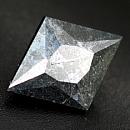|
|
||||||||||||||||
|
||||||||||||||||
|
||||||
|
|
|
|
Chalcocite
|
|
| | |
| Discovered in 1832; IMA status: Valid (pre-IMA; Grandfathered) | ||
|
| ||
|
Chemistry |
|
|
| |
|
Cu2S | |
|
|
Copper Sulfate |
|
Molecular Weight: |
159.16 gm |
|
Composition: |
Copper |
79.85 % |
Cu |
|
|
|
|
Sulfur |
20.15 % |
S |
|
|
|
|
|
100.00 % |
|
|
|
|
|
|
||||
|
Classification |
|
|
| |
|
Sulfides | |
|
2/B.01-10 | |
|
|
2 : SULFIDES and SULFOSALTS (sulfides, selenides,
tellurides; arsenides, antimonides, bismuthides; sulfarsenites,
sulfantimonites, sulfbismuthites, etc.) |
|
Related to: |
Chalcocite-Digenite Group. Chalcocite-Yarrowite Series. |
|
Members of Group: |
Chalcocite-Digenite Group: Chalcocite, Digenite, Djurleite, Roxbyite |
|
Varieties: |
Argentiferous Chalcocite, Ducktownite, Harrisite, Para-Kupferglanz |
|
Synonyms: |
Chalcocine, Chalcosine, Chalcosite, Copper Glance, Cuprein, Cupreine, Cyprite, Kuprein, Redruthite, Vitreous Copper |
|
|
|
|
Crystal Data |
|
|
|
|
|
Crystals are short prismatic [001], thick to tabular {001}, to 12 cm across, and prismatic [100], to 25 cm long; {001} is striated || [100]. Massive, compact, fine powdery. |
|
|
Common on {110} yielding pseudohexagonal stellate forms; also on {032}, {112}. Seen as lamellar twinning in polished section. |
|
|
|
|
|
Physical Properties |
|
|
|
|
|
Indistinct on {110} |
|
|
Conchoidal |
|
|
Brittle, somewhat sectile. |
|
|
2.5 - 3.0; VHN = 8487 (100 g load) |
|
|
5.50 - 5.80 (g/cm3) |
|
|
None |
|
|
Not Radioactive |
|
|
|
|
|
Optical Properties |
|
|
|
|
|
Blue Black, Gray, Black, Black Gray, or steel Gray |
|
|
Opaque |
|
|
Metallic |
|
|
R1R2: (400) 37.036.8, (420) 37.837.4, (440) 37.737.6, (460) 37.037.2, (480) 36.236.2, (500) 35.635.4, (520) 34.734.4, (540) 33.733.5, (560) 32.532.5, (580) 32.131.8, (600) 31.331.2, (620) 30.830.7, (640) 30.030.0, (660) 29.530.0, (680) 29.229.7, (700) 29.029.6 |
|
|
None; Opaque |
|
|
None |
|
|
None |
|
|
Weak |
|
|
|
|
|
Occurances |
|
|
|
|
|
Geological Setting: |
An uncommon primary hydrothermal mineral but important as a secondary mineral. Found in or below the zone of oxidation in hydrothermal veins and in large low-grade porphyry copper orebodies. |
|
Common Associations: |
Pyrite, Chalcopyrite, Covellite, Bornite, Molybdenite, many other sulfides and their alteration products. |
|
Common Impurities: |
Fe |
|
Co-type Localities: |
·
Cornwall, England,
|
|
Year Discovered: |
1832 |
|
View mineral photos: | |
|
|
|
|
More Information |
|
|
|
|
|
| |
|
|
|
|
Since Chalcocite is a secondary mineral that forms from the alteration of other minerals, it has been known to form pseudomorphs of many different minerals. A pseudomorph is a mineral that has replaced another mineral atom by atom, but it leaves the original mineral's crystal shape intact. Chalcocite has been known to form pseudomorphs of the minerals Bornite, Covellite, Chalcopyrite, Pyrite, Enargite, Galena and Sphalerite. Pseudo means false and morph means shape or form, thus pseudomorph means false shape since the mineral is Chalcocite but the shape is that of another crystal, Covellite for example. Distribution:
An important and widely distributed ore mineral of copper.
Only a few localities producing exceptional crystals
or pure masses can be listed. From the Turinsk copper
mine, Bogoslovsk, Ural Mountains, Russia. In England,
fine crystals from Cornwall at St. Just, St. Ives, Camborne,
and Redruth. In the USA, exceptional crystals from Bristol,
Hartford County, Connecticut; in Arizona, at Bisbee,
Cochise County; from the Magma mine, Superior, Pinal
County; in the United Verde Extension mine, Yavapai
County; from Butte, Silver Bow County, Montana; crystals
at the Flambeau mine, southwest of Ladysmith, Rusk County,
Wisconsin; from Kennicott, Copper River district, Alaska.
Large crystals from Nababiep West mine, Cape Province,
and Messina, Transvaal, South Africa. At MPassa, Niari
Province, Congo Republic. In the Mashamba West mine,
Kolwezi, Katanga Province, Congo (Shaba Province, Zaire).
Fine crystals from Telfer, Western Australia. |
|
|
We
have not photographed our Chalcocite gems yet. Please
check back soon. |
